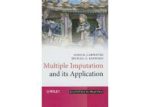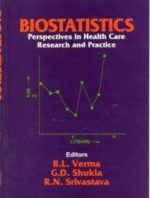-
Multiple Imputation and its Application
KSh 12,460.00Collecting, analysing and drawing inferences from data is central to research in the medical and social sciences. Unfortunately, it is rarely possible to collect all the intended data. The literature on inference from the resulting incomplete data is now huge, and continues to grow both as methods are developed for large and complex data structures, and as increasing computer power and suitable software enable researchers to apply these methods.
This book focuses on a particular statistical method for analysing and drawing inferences from incomplete data, called Multiple Imputation (MI). MI is attractive because it is both practical and widely applicable. The authors aim is to clarify the issues raised by missing data, describing the rationale for MI, the relationship between the various imputation models and associated algorithms and its application to increasingly …
-
Health Informatics: An Interprofessional Approach 2nd Edition
KSh 11,800.00Awarded second place in the 2017 AJN Book of the Year Awards in the Information Technology category. See how information technology intersects with health care! Health Informatics: An Interprofessional Approach, 2nd Edition prepares you for success in today’s technology-filled healthcare practice. Concise coverage includes information systems and applications such as electronic health records, clinical decision support, telehealth, ePatients, and social media tools, as well as system implementation. New to this edition are topics including data science and analytics, mHealth, principles of project management, and contract negotiations. Written by expert informatics educators Ramona Nelson and Nancy Staggers, this edition enhances the book that won a 2013 American Journal of Nursing Book of the Year award!
Experts from a wide range of health disciplines cover the latest on the interprofessional aspects of informatics ― a key Quality and Safety Education for Nurses (QSEN) initiative and a growing specialty area in nursing.
Case studies encourage higher-level thinking about how concepts apply to real-world nursing practice.
Discussion questions challenge you to think critically and to visualize the future of health informatics.
Objectives, key terms and an abstract at the beginning of each chapter provide an overview of what you will learn.
Conclusion and Future Directions section at the end of each chapter describes how informatics will continue to evolve as healthcare moves to an interprofessional foundation.
NEW! Updated chapters reflect the current and evolving practice of health informatics, using real-life healthcare examples to show how informatics applies to a wide range of topics and issues.
NEW mHealth chapter discusses the use of mobile technology, a new method of health delivery ― especially for urban or under-served populations ― and describes the changing levels of responsibility for both patients and providers.
NEW Data Science and Analytics in Healthcare chapter shows how Big Data ― as well as analytics using data mining and knowledge discovery techniques ― applies to healthcare.
NEW Project Management Principles chapter discusses proven project management tools and techniques for coordinating all types of health informatics-related projects.
NEW Contract Negotiations chapter describes strategic methods and tips for negotiating a contract with a healthcare IT vendor.
NEW Legal Issues chapter explains how federal regulations and accreditation processes may impact the practice of health informatics.
NEW HITECH Act chapter explains the regulations relating to health informatics in the Health Information Technology for Education and Clinical Health Act as well as the Meaningful Use and Medicare Access & CHIP Reauthorization Act of 2015. -
Biostatistics: Perspectives In Health Care Research & Practice
KSh 11,235.001. Health Surveys. K.Raghav Prasad2. Sample size determination Sheela Taiwalkar3. Measuring morbidity from pulmonary tuberculosis KB. Gauzam4. Methods of mortality data analysis. S. Mukerji and S. Lahiri5. Path coefficient analysis in medicine. V.G. Kaliaperwnal and N. Sundararaj6. Categorization of health data and their analysis. A. Indrayan7. Discrete response analysis in population an application of branching process. Bandyopadhyay8. Survival analysis in clinical data Samir K. Bhattacharya9. Discriminant analysis in medical diagnosis. T. Krishnan10. Statistical modelling in health and disease. B.L. Verma11. Operations research in health care Y.P. Gupta12. Methods of monitoring, assessment and evaluation of health programmes.
-
Biostatistics: Perspective in Health Care Paperback
KSh 11,235.001. Health Surveys. K.Raghav Prasad 2. Sample size determination Sheela Taiwalkar 3. Measuring morbidity from pulmonary tuberculosis KB. Gauzam 4. Methods of mortality data analysis. S. Mukerji and S. Lahiri 5. Path coefficient analysis in medicine. V.G. Kaliaperwnal and N. Sundararaj 6. Categorization of health data and their analysis. A. Indrayan 7. Discrete response analysis in population control: an application of branching process. Bandyopadhyay 8. Survival analysis in clinical data Samir K. Bhattacharya 9. Discriminant analysis in medical diagnosis. T. Krishnan 10. Statistical modelling in health and disease. B.L. Verma 11. Operations research in health care Y.P. Gupta 12. Methods of monitoring, assessment and evaluation of health programmes.




